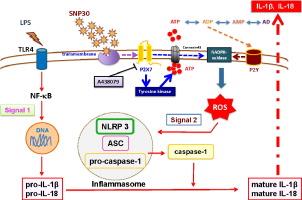Silica nanoparticles activate purinergic signaling via P2X7 receptor in dendritic cells,leading to production of pro-inflammatory cytokines |
| |
| Affiliation: | 1. Department of Radiation Biosciences, Generation, Research Institute for Science and Technology, Tokyo University of Science (TUS), 2641 Yamazaki, Noda-shi, Chiba 278-8510, Japan;2. Biochemistry, Faculty of Pharmaceutical Sciences, Generation, Research Institute for Science and Technology, Tokyo University of Science (TUS), 2641 Yamazaki, Noda-shi, Chiba 278-8510, Japan;3. The Center for Environmental Health Science for the Next, Generation, Research Institute for Science and Technology, Tokyo University of Science (TUS), 2641 Yamazaki, Noda-shi, Chiba 278-8510, Japan;1. Leibniz Institute of Photonic Technology, Jena, Germany;2. Institute of Physical Chemistry, Abbe Center of Photonics, Friedrich-Schiller-University, Jena Germany;3. Lomonosov Moscow State University, Physics Department, Moscow, Russia;4. National Research Nuclear University MEPhI, Moscow, Russia;1. Department of Pharmacology, Pharmacy and Pharmaceutical Technology, CIMUS Research Institute, Universidade de Santiago de Compostela, 15782 Santiago de Compostela, Spain;2. Veneto Institute of Oncology IOV-IRCCS, 35128 Padova, Italy;3. Institute for Molecular Engineering, The University of Chicago, Chicago, IL, USA;4. Department of Medicine, Verona University Hospital, 37134 Verona, Italy;5. ARC Centre of Excellence in Convergent Bio-Nano Science and Technology, and Drug Delivery, Disposition and Dynamics, Monash Institute of Pharmaceutical Sciences, Monash University, Parkville Campus, 381 Royal Parade, Parkville, VIC 3052, Australia;1. Neurobiology of Pain Laboratory, Departamento de Farmacobiología, Centro de Investigación y de Estudios Avanzados (Cinvestav), Sede Sur. Calzada de los Tenorios 235, Col. Granjas Coapa, 14330 México, D.F., Mexico;2. Sección de Estudios de Posgrado e Investigación, Escuela Superior de Medicina, Instituto Politécnico Nacional, Plan de San Luis y Díaz Mirón s/n, Col. Casco de Santo Tomas, Miguel Hidalgo, 11340 México, D.F., Mexico;3. Unidad de Investigación en Farmacología, Instituto Nacional de Enfermedades Respiratorias, Ismael Cosio Villegas, Secretaría de Salud, Calzada de Tlalpan 4502, Col. Sección XVI, Tlalpan, 14080 México, D.F., Mexico |
| |
| Abstract: | 
We examined the mechanism of SNP-mediated stimulation of IL-1β and IL-18 production via P2R-mediated pathways in mouse bone marrow dendritic cells (mBMDCs). Examination of uptake of SNPs with diameters of 30, 70, and 300 nm (SNP30, SNP70, and SNP300, respectively) by lipopolysaccharide-matured mBMDCs revealed that significant uptake of SNP30 occurred within as short a time as 1 h. Production of IL-1β and IL-18 by cells exposed to SNPs increased dose-dependently, and was highest in cells exposed to SNP30. The SNP30-induced cytokine production was significantly inhibited by ATPase (apyrase) and by P2X7 receptor antagonist (A438079). ATP release was also highest in SNP30-exposed cells. Treatment of mBMDCs with exogenous ATP induced release of high levels of IL-1β and IL-18, and this release was also significantly inhibited by apyrase and A438079. The order of effectiveness of the three SNPs for inducing intracellular reactive oxygen species (ROS) production accorded well with those of cytokine production and ATP release. ROS production was inhibited by diphenyleneiodonium chloride (DPI). SNPs, especially SNP30, activate purinergic signaling in matured mBMDCs by inducing ATP release via P2X7 receptor. ATP induces ROS production via NADPH oxidase, and ROS activate inflammasomes, leading to caspase-1-dependent processing of pro-cytokines and release of IL-1β and IL-18. |
| |
| Keywords: | |
| 本文献已被 ScienceDirect 等数据库收录! |
|

